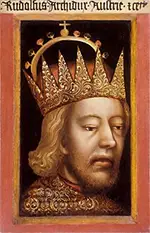Rudolf IV: Duke of Austria and Styria
Rudolf IV was Duke of Austria and Styria for seven years in the mid-14th Century. 
He was born on Nov. 1, 1339, in Vienna, the son of Albert II and Joanna of Pfirt. He was married at 18 to Catherine of Bohemia, whose was father was the Holy Roman Emperor Charles IV. Albert died in 1358, and Rudolf succeeded him as Duke of Austria and Styria. Albert had ruled together with his brother Otto, but the latter had predeceased the former. The duke is perhaps most well-known for a stunt of forgery. Charles IV had issued the Golden Bull of 1356, which solidified the list of electors who were to choose the King of the Romans (Germany). For many years, this had been an elected position. That Golden Bull named seven prince-electors who would have full power to choose their next leader. Those seven were the Archbishop of Cologne, the Archbishop of Mainz, the Archbishop of Trier, the Count Palatine of the Rhine, the Duke of Saxony-Wittenberg, the King of Bohemia, and the Margrave of Brandenburg. Nowhere in that seven was the Duke of Austria or anyone of the Habsburg line. An incensed Rudolf issued an official reply two years later in the form of the Privilegium maius, a series of "found" documents that elevated Austria to the status of an archduchy, with rights equal to the prince-electors named Charles IV's Golden Bull. The emperor recognized this claim for the falsity that it was and refused to recognize the Habsburg ruler's claims. The thwarted Rudolf made it a priority to enhance the viability and prestige of Vienna. He founded the university in that city in 1365 and introduced other measures to improve the city's economy and standing. Elsewhere, Rudolf, by various means, took over the County of Tyrol and March of Carniola, making the latter a duchy. Rudolf IV died without warning on July 27, 1365, in Milan. He had no children. Succeeding him were his younger brothers Albert and Leopold. |
|
Social Studies for Kids
copyright 2002–2024
David White




